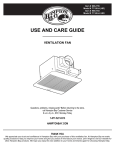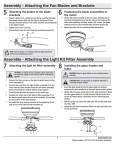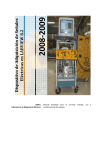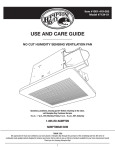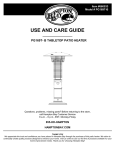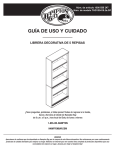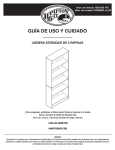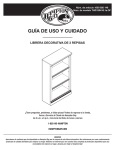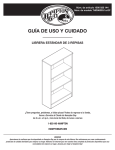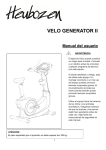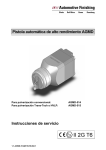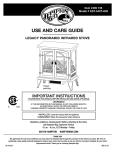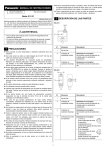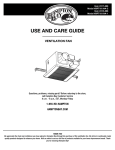Download Hampton Bay PG171H-B Use and Care Manual
Transcript
Item #660534 Model #PG171H-B USE AND CARE GUIDE PG171H-B PATIO HEATER Questions, problems, missing parts? Before returning to the store, call Hampton Bay Customer Service 8 a.m. - 6 p.m., EST, Monday-Friday 855-HD-HAMPTON HAMPTONBAY.COM THANK YOU We appreciate the trust and confidence you have placed in Hampton Bay through the purchase of this patio heater. We strive to continually create quality products designed to enhance your home. Visit us online to see our full line of products available for your home improvement needs. Thank you for choosing Hampton Bay! Table of Contents Table of Contents .......................................................... 2 Safety Information ......................................................... 2 Warranty ......................................................................... 4 Pre-Assembly ................................................................ 5 Planning Assembly ..................................................... 5 Tools required ............................................................ 5 Hardware Included ..................................................... 5 Package Contents ...................................................... 6 Assembly ...................................................................... 7 Operation .................................................................... 12 Care and Maintenance ................................................ 14 Troubleshooting.......................................................... 15 Service Parts ............................................................... 16 Safety Information Please read and understand this entire manual before attempting to assemble, operate or install the product □ □ DANGER: Store the cylinder outdoors in a well-ventilated area (not in a building, garage, or other enclosed area) out of the reach of children. CALIFORNIA PROPOSITION 65 WARNING: Chemicals known to the state of California to cause cancer, birth defects or other reproductive harm are created by combustion of propane. The installation must conform with local codes or, in the absence of local codes, with the National Fuel Gas Code, ANSI Z223.1 /NFPA 54, Natural Gas and Propane Installation Code, CSA B149.1, or Propane Storage and Handling Code, B149.2. DANGER: Do not store a spare LP-gas cylinder under or near this appliance. DANGER: Never fill the cylinder beyond 80 percent full. DANGER: Young children should be carefully supervised when they are in the area of the item. DANGER: FOR YOUR SAFETY If you smell gas: 1. Shut off gas to the appliance. 2. Extinguish any open flame. 3. If odor continues, keep away from the appliance and immediately call you gas supplier or fire department. DANGER: Keep the ventilation opening(s) of the cylinder enclosure free and clear from debris. Use this appliance in a well-ventilated space only. Do not use it in a building, garage or any other enclosed area. WARNING: Do not store or use gasoline or other flammable vapors and liquids in the vicinity of this or any other appliance. An LP-cylinder not connected for use shall not be stored in the vicinity of this or any other appliance. DANGER: Use this appliance in outdoor areas described below: (a) With walls on all sides, but at least one permanent opening at ground level and no overhead cover. (b) Within a partial enclosure that includes overhead cover and no more than two walls. These walls may be parallel, or at right angles to each other. (c) Within a partial enclosure that includes overhead cover and no more than two walls. The following shall apply: (i) One wall that is equivalent to at least 25% of the total wall area is completely open. (ii) 30% or more in total of the remaining wall area is open and unrestricted. WARNING: For Outdoor Use Only WARNING: Improper installation, adjustment, alteration, service or maintenance can cause property damage, injury or death. Read the installation, operation and maintenance instructions thoroughly before installing or servicing this equipment. 2 Safety Information (continued) WARNING: Perform a leak test with a soapy solution: (a) To check gas connections. (b) After connecting a new cylinder. (c) Upon re-assembly after disassembly. Please refer to the leak test procedure indicated in this instruction manual on page 12. WARNING: Storage of an appliance indoors is permissible only if the cylinder is disconnected and removed from the appliance. WARNING: Materials or items when stored under the heater will be subjected to intense heat and could be seriously damaged. WARNING: Replace the hose assembly prior to the appliance being put into operation if there is evidence of excessive abrasion or wear, or if the hose is damaged. The pressure regulator and hose assembly supplied with the appliance must be used. The replacement hose assembly/regulator shall be that specified by the manufacturer. WARNING: Clothing or other flammable materials should not be hung on the heater, or placed on, under or near the heater. WARNING: Children and adults should be alerted to the hazards of high surface temperatures and should stay away from the item to avoid burns or clothing ignition. WARNING: Place the propane hose with regulator assembly out of pathways where people may trip over it or in areas where the hose will not be subjected to accidental damage. WARNING: Place the dust cap tightly on the cylinder valve outlet whenever the cylinder is not in use. Install only the type of dust cap on the cylinder valve that is provided with the cylinder valve. Other types of caps or plugs may result in a propane leak. WARNING: The cylinder used must include a collar to protect the cylinder valve. WARNING: Installation and repair should be done by qualified service person; the heater should be inspected before use and at least annually by a qualified service person. CAUTION: Minimum clearance to the combustible materials is 36 inches. WARNING: Do not obstruct the flow of combustion and ventilation air. CAUTION: If you don’t feel the heater is on a stable surface, use a ground screw to fix the base of the heater on the surface where the heater is installed. Fix the base on an incline no wider than 15 degrees. WARNING: The LP-gas supply cylinder to be used must be: (a) Constructed and marked in accordance with the Specifications for LP-gas cylinders of the U.S. Department of Transportation of Dangerous Goods and Commission, CAN/CSA-B339, as applicable; (b) Provided with a listed overfilling prevention device; (c) Provided with a cylinder connection device compatible with the connection for the appliance. CAUTION: This heater is equipped with a battery-operated ignition device; please refer to the Assembly Instructions on page 12. CAUTION: Any guard or other protective device removed for servicing the heater must be replaced prior to operating the heater. WARNING: Disconnect the cylinder when the appliance is not in use. CAUTION: More frequent cleaning may be required as necessary. It is imperative that the control compartment, burners and circulating air passageways of the heater to kept clean. 3 HAMPTONBAY.COM Please contact 855-HD-HAMPTON for further assistance. Safety Information (continued) CAUTION: Keep the appliance area clear and free from combustible materials, gasoline and other flammable vapors and liquids. CAUTION: An instruction to inspect the visible portion of the hose before each use of the appliance. When portions of the hose are located within the confines of the heater post, instructions to inspect the entire hose assembly at least annually. If disassembly is required, the instructions shall also include the proper procedure for leak checking the connections upon re-assembly. CAUTION: Inspect the visible portion of the hose before each use of the appliance. CAUTION: Inspect the visible portion of the hose before each use of the appliance. Check for leaks after connecting the gas cylinder every time according to the “Checking for Leaks” section. Periodically check the hose located within the confines of the cylinder housing for damage. CAUTION: More frequent cleaning may be required as necessary. It is imperative the control compartment, burners and circulating air passageways of the heater are kept clean. CAUTION: Keep this manual for future reference and to educate new users of this product. CAUTION: Every part of the heater shall be secure against displacement and shall be constructed to maintain a fixed relationship between essential parts under normal and reasonable conditions of handling and usage. Parts not permanently secured shall be designed so they cannot be incorrectly assembled and cannot be improperly located or misaligned in removing or replacing during cleaning or other servicing. Warranty ONE-YEAR LIMITED WARRANTY The appliance has been manufactured under the highest standards of quality and workmanship. We warrant to the original consumer / purchaser that all aspects of this product will be free of defects in material and workmanship for one (1) year from the date of purchase. A replacement for any defective part will be supplied free of charge for installation by the consumer. Defects or damage caused by the use of other than genuine parts are not covered by this warranty. This warranty shall be effective from the date of purchase as shown in the purchaser’s receipt. This warranty is valid for the original consumer purchaser only and excludes industrial, commercial or business use of the product, product damage due to shipment or failure which results from alteration, product abuse, or product misuse, where performed by a container, service company, or consumer. We will not be responsible for labor charges and/or damage incurred in installation, repair or replacement, nor for incidental or consequential damage. This warranty gives you specific legal rights, and you may also have the other rights that vary from state to state. 4 Pre-Assembly PLANNING ASSEMBLY Before beginning assembly of product, make sure all parts are present. Compare parts with the Hardware Included and Package Contents lists. If any part is missing or damaged, do not attempt to assemble the product. Contact customer service for replacement part. NOTE: Estimated Assembly Time: 30 minutes TOOLS REQUIRED Phillips screwdriver Wrench HARDWARE INCLUDED NOTE: Hardware shown to actual size. AA GG BB HH CC II DD JJ EE KK Part Description AA BB CC M8 x 15 mm Bolt M5 x 8 mm Black Bolt M8 Nut Quantity 2 5 2 DD EE FF GG HH II JJ Battery ST 4.2 x 8 mm Screw M6 x 10 mm Bolt M5 x 8 mm Silver Bolt M5 Nut M5 Washer Reflector Spacer 1 4 4 15 12 12 3 KK Wing Nut 3 FF 5 HAMPTONBAY.COM Please contact 855-HD-HAMPTON for further assistance. Pre-Assembly (continued) PACKAGE CONTENTS Part A B C D E Description Top Dome KD Dome Burner Assembly Pole Assembly Table Quantity Part 1 4 1 1 1 F G H I J 6 Description Table Support Assembly Deck Ring Cylinder Assembly Base Wheel Assembly Quantity 1 1 1 1 1 Assembly 1 □ 2 Assembling the Wheel Assembly With the base (I) upside down, attach the wheel assembly (J) using M8 x 15 mm bolts (AA) and M8 nuts (CC). □ Assemble the Cylinder Assembly Turn the base (I) right-side up, then attach the cylinder assembly (H) with M5 x 8 mm black bolts (BB) though the preassembled L-pins. NOTE: The door on the cylinder assembly (H) should be on the opposite side of the wheel assembly (J). I AA H CC J J I 7 BB HAMPTONBAY.COM Please contact 855-HD-HAMPTON for further assistance. Assembly (continued) 3 □ 4 Assembling the Pole Attach the pole (D) to the cylinder assembly (H) using M5 x 10 mm bolts (FF). □ Assembling the Table Support Assembly Attach the table support assembly (F) to the table (E) with ST 4.2 x 8 mm screws (EE). NOTE: Ensure the pole (D) is straight. Then, use the deck ring (G) to cover the connection. Back EE D G E FF H 8 F Assembly (continued) 5 □ 6 Assembling the Table Unlock the handle on the table support assembly (F), then insert the table (E) onto the pole assembly (D). Once the desired height is achieved, release the handle to re-lock the table support assembly (F). □ Assembling the Reflector Spacer Insert reflector spacers (JJ) into the top of the burner assembly (C). JJ D E F C 9 HAMPTONBAY.COM Please contact 855-HD-HAMPTON for further assistance. Assembly (continued) 7 □ 8 Assembling the Burner Assembly Thread the regulator assembly preassembled to the burner assembly (C) through the pole assembly (D). Once the burner assembly (C) rests on the pole assembly (D), secure with M5 x 8 mm silver bolts (GG). Assembling the KD and Top Dome □ Attach the KD domes (B) using M5 x 8 mm bolts (GG), M5 nuts (HH) and 5 mm washers (II). Then, complete the dome assembly by attaching the top dome (A) to the KD domes (B) with M5 x 8 mm silver bolts (GG), M5 nuts (HH) and 5 mm washers (II). B HH C II GG D HH A GG II GG 10 Assembly (continued) □ 10 Attach the dome assembly to the burner assembly (C) using wing nuts (KK). A □ KK B □ Assembling the Cylinder Connect the preassembled regulator assembly from the burner assembly (C) to a 20-lb. LP-gas cylinder (sold separately). Line up threads on the cylinder fitting with those on the regulator and rotate clockwise until tight. HAND TIGHTEN ONLY. DO NOT USE ANY HAND TOOLS TO MAKE THIS CONNECTION. Be careful not to cross threads when screwing in fitting. To disconnect the LP-gas cylinder, first make sure the cylinder valve is in the "OFF" position. Then, turn the knob on the regulator assembly counterclockwise until it is loose WARNING: Before connecting, be sure there is no debris caught in the head of the LP-gas cylinder regulator valve or in the head of the burner and burner ports. C 20lbs lbs 20 17.9 imch 9 Assembling the Dome Assembly 17.9 in. 12.2 inch 12.2 in. 11 HAMPTONBAY.COM Please contact 855-HD-HAMPTON for further assistance. Assembly (continued) 11 Securing the Cylinder □ 12 Attach the belt inside of the cylinder assembly (H) to secure the cylinder. Then, close the door on the cylinder assembly (H). □ Assembling the Battery To install the battery (DD), unscrew the igniter cap preassembled to the burner assembly (C). Insert the battery (DD) into the igniter, ensuring the positive "+" end faces outward. Then replace the igniter cap. H Igniter Igniter C DD Operation CHECKING FOR LEAKS □ □ □ Make leakage solution by mixing 1-part liquid dish soap and 3-parts water. Spoon or brush several drops (or use squirt bottle) of the solution onto the gas hose/regulator and regulator/cylinder and hose connections. Turn on the gas cylinder valve. Inspect the connections and look for bubbles. 1. If no bubbles appear, the connection is safe. 2. If bubbles appear, there is leakage. Loosen and re-tighten this connection. If it still leaks, please call customer service. 12 Operation (continued) LIGHTING INSTRUCTIONS □ □ □ □ □ Turn the LP gas cylinder valve OFF. Push the control knob on the pole in, turn OFF, and wait 5 minutes for any gas to clear. Turn the tank valve ON. Push the control knob in and rotate to PUSH. Then push the igniter button and control knob until the burner is ignited. If the burner fails to remain lit or becomes extinguished, repeat this step after 5 minutes of complete shutoff period before relighting. Once the burner has lit, continue to hold the control knob in for 30 seconds, and then release. Turn the control knob from LOW to HIGH to the desired heat setting. Visually check the burner flame against the illustrations below: 1. Flame should be blue with slight yellow tips. 2. You should see a smaller flame in LOW position than seen on HIGH. Perform flame check prior to each use. If only low flame is seen, refer to “Burner flame is low” in the “Troubleshooting” section. HIGH LOW □ For complete shutdown: 1. Please turn the knob to “Push” position first, then push and turn to “Off” position for complete shut off. 2. Turn the LP gas tank valve OFF before remove the LP gas tank. □ If you are unable to ignite the heater using the normal method, please use the ignition bar with a match to reach the burner for ignition through the hole on the bottom of burner diffuser. Insert the match from the back side of the burner assembly which is opposite of the control panel. WARNING: DO NOT touch or move the heater for at least 45 minutes after use. Allow the emitter and dome to cool before touching. WARNING: Avoid inhaling fumes emitted from the heater’s first use. Smoke and odor from the burning of oils used in manufacturing will appear. Both smoke and odor will dissipate after approximately 30 minutes. The heater should NOT produce thick black smoke. WARNING: If at any time you are unable to light the burner and smell gas, wait 5 minutes to allow gas to dissipate before attempting to light the heater. 13 HAMPTONBAY.COM Please contact 855-HD-HAMPTON for further assistance. Care and Maintenance □ □ □ □ □ □ □ □ □ □ □ □ □ Abrasive cleaners will damage this product. Never use oven cleaner to clean any part of the heater. Do not clean any heater part in a self-cleaning oven. The extreme heat will damage the finish. More frequent cleaning may be required as necessary. It is imperative that the control compartment, burners and circulating air passageways of the heater be kept clean. Spiders and insects can create a dangerous condition that may damage the heater or make it unsafe. Keep the burner area clean of all spiders, webs or insects. Clean burner holes by using a heavy-duty pipe cleaner. Compressed air may help clear away smaller particles. Inspect the heater before each use. Have the heater inspected annually and ensure repairs are made by a qualified service person. Check the heater immediately if any of the following conditions exist: a. The smell of gas in conjunction with extreme yellow tipping of burner flames. b. The heater does not reach proper temperature. c. The heater’s glow is excessively uneven. d. The burner makes popping noises during use. This is normal when extinguishing the burner. Carbon deposits may create a fire hazard. Keep the dome and emitter clean at all times. Do not clean the heater with combustible or corrosive cleaners. Use warm, soapy water. Do not paint the engine, engine access panel or dome. This heater should be thoroughly cleaned on a regular basis. After a period of storage and/or non use, check for leaks, burner obstructions and inspect for any abrasion, wear, cuts to the hose. CLEANING □ □ □ Wipe surfaces clean with mild dish detergent or baking soda. For stubborn surfaces use a citrus-based degreaser and a nylon scrubbing brush. Rinse clean with water. NOTE: 1. While cleaning your unit, be sure to keep the area around the burner dry at all times. Do not submerge the control valve assembly. If the gas control is submerged in water, do NOT use it. It must be replaced. 2. Use high-quality automobile wax to help maintain the appearance of the heater. Apply to exterior surfaces from the pole down. Do not apply to emitter screen or domes MAINTENANCE □ □ □ Keep exterior surfaces clean. Air flow must be unobstructed. Keep the controls, burner and circulating air passageways clean. Signs of possible blockage include: Gas odor with extreme yellow tipping of flame. The heater does NOT reach the desired temperature. The heater glow is excessively uneven. The heater makes popping noises. NOTE: In a salt-air environment (such as near an ocean) corrosion occurs more quickly than normal. Frequently check for corroded areas and repair them promptly. 14 Care and Maintenance STORAGE □ Between uses or during periods of extended inactivity: Turn control knob to the "OFF" position. Disconnect the LP cylinder and move to a secure, well-ventilated location outdoors. Store the heater upright in an area sheltered from direct contact with inclement weather (such as rain, sleet, hail, snow, dust and debris). NOTE: Never leave LP gas tank exposed to direct sunlight or excessive heat. If desired, use cover (s) to protect the heater and help prevent buildup in air passages. CAUTION: THD Wait until heater is cool before covering. Troubleshooting PROBLEM The burner does not light. The burner flame is low. There is carbon build up. There is thick black smoke. POSSIBLE CAUSE 1. The gas pressure is low. 2. The orifice is blocked. 3. The control knob is not in the “ON” position. 1. The gas pressure is low. 2. The control knob is not positioned at “High”. 3. The burner jet is partially blocked. 4. Outdoor temperature is less than 40°F and tank is less than 1/4 full. 5. The supply hose is bent or kinked. Seasonal accumulation. There is blockage in the burner. CORRECTIVE ACTION 1. Turn the gas cylinder valve “OFF” and replace the cylinder. 2. Clear the blockage. 3. Turn the control knob to the "ON" position. 1. Turn the gas cylinder valve “OFF” and replace the cylinder. 2. Position the control knob to the "HIGH" position. 3. Clear blockage. 4. Use a full gas cylinder. 5. Straighten the hose. Wipe off before lighting. Remove blockage and clean the burner inside and outside. 15 HAMPTONBAY.COM Please contact 855-HD-HAMPTON for further assistance. Service Parts Part Description Quantity Part Description Quantity 1 2 Top Dome KD Dome 1 4 9 10 Table Table Support Assembly 1 1 3 4 5 6 7 8 Burner Chamber Assembly Burner Assembly Knob Valve Shroud Cover Igniter Pole Assembly 1 1 1 1 1 1 11 12 13 14 15 16 Deck Ring Cylinder Assembly Base Wheel Support Shroud Fix Bracket Weight Plate 1 1 1 1 5 1 16 Questions, problems, missing parts? Before returning to the store, call Hampton Bay Customer Service 8 a.m. - 6 p.m., EST, Monday-Friday 855-HD-HAMPTON HAMPTONBAY.COM Retain this manual for future use. 18 Núm. de artículo 660534 Núm. de modelo PG171H-B GUÍA DE USO Y CUIDADO CALEFACTOR DE PATIO PG171H-B ¿Tiene preguntas, problemas, o faltan piezas? Antes de regresar a la tienda, llame a Servicio al Cliente de Hampton Bay de lunes a viernes de 8 a.m. y 6 p.m., hora local del Este 855-HD-HAMPTON HAMPTONBAY.COM GRACIAS Agradecemos la confianza que ha puesto en Hampton Bay a través de la compra de calefactor de patio. Nos esforzamos por crear continuamente productos de calidad diseñados para mejorar su hogar. Visítenos en internet para ver nuestra línea completa de productos disponibles para sus necesidades de mejorar su hogar. ¡Gracias por elegir a Hampton Bay! Tabla de contenido Tabla de contenido ....................................................... 2 Información de seguridad ............................................ 2 Garantía .......................................................................... 4 Pre-ensamblado ............................................................ 5 Planificación del ensamblaje ...................................... 5 Herramientas requeridas ............................................ 5 Herraje incluido .......................................................... 5 Contenido del paquete ............................................... 6 Ensamblaje .................................................................... 7 Operación .................................................................... 12 Cuidado y mantenimiento .......................................... 14 Resolución de fallas ................................................... 15 Piezas de servicio ....................................................... 16 Información de seguridad Por favor, lea y comprenda este manual completo antes de intentar ensamblar, operar o instalar el producto. □ □ PELIGRO: Guarde el cilindro en exteriores en un área bien ventilada (no en edificios, garajes, u otra área encerrada) lejos del alcance de los niños. ADVERTENCIA DE LA PROPUESTA 65 DE CALIFORNIA: La combustión del propano genera productos químicos que el Estado de California sabe que causan cáncer, defectos de nacimiento u otros daños reproductivos. La instalación debe hacerse conforme a los códigos locales o, en ausencia de códigos locales, conforme al Código Nacional de Gas Combustible, ANSI Z223.1 /NFPA 54, Código de Instalación de Gas Natural y Propano, CSA B149.1, o Código de Almacenamiento y Manejo de Propano, B149.2. PELIGRO: No guarde un cilindro de gas PL de repuesto bajo o cerca de este aparato. PELIGRO: Nunca llene el cilindro más allá del 80 por ciento de su capacidad. PELIGRO: PARA SU SEGURIDAD Si percibe olor a gas : 1. Cierre el suministro de gas hacia el electrodoméstico. 2. Apague cualquier llama directa. 3. Si el olor persiste, manténgase alejado del electrodoméstico y llame de inmediato a su proveedor de gas o al departamento de bomberos. PELIGRO: Los niños pequeños deben ser supervisados cuidadosamente cuando se encuentren en el área del calefactor. PELIGRO: Mantenga las aberturas de ventilacion del recinto del cilindro libres y limpias de desechos. Use este aparato en un espacio bien ventilado únicamente. No lo use en edificios, garajes, o cualquier otra área encerrada. ADVERTENCIA: No almacene ni utilice gasolina u otros vapores o líquidos Inflamables cerca de éste u otro electrodoméstico. No deben almacenarse cilindros de gas propano que no estén conectados y en uso cerca de éste ni de ningún otro electrodoméstico. PELIGRO: Use este aparato en áreas de exteriores como se describe a continuación: (a) Con paredes en todos los lados, pero al menos una abertura permanente a nivel del suelo y sin cubierta superior. (b) Dentro de un recinto parcial que incluya cubierta superior y no más de dos paredes. Estas paredes deben estar paralelas, o a ángulos rectos entre sí. (c) Dentro de un recinto parcial que incluya cubierta superior y no más de dos paredes. Aplicará lo siguiente: (i) Una pared equivalente a al menos el 25% del área de pared total está completamente abierta. (ii) 30% o más en total del área de pared restante está abierta y sin restricciones. ADVERTENCIA: Sólo para uso en exteriores ADVERTENCIA: La instalación,el ajuste,la alteración,la reparación o el mantenimiento inadecuados pueden ocasionar daños a la propiedad,lesiones o la muerte.Lea con detención las instrucciones de instalación,operación y mantenimiento antes de instalar o reparar este equipo. 2 Información de seguridad (continuación) ADVERTENCIA: Realice una prueba de fugas con una solución jabonosa: (a) Para revisar las conexión de gas. (b) Después de la conexión de un cilindro nuevo. (c) En el reensamblaje después del desmontaje. Consulte el procedimiento de prueba de fugas indicado en este manual de instrucción en la página 12. ADVERTENCIA: El almacenamiento de un aparato en interiores es permisible solamente si el cilindro está desconectado y retirado del aparato. ADVERTENCIA: Los materiales y artículos almacenados debajo del calefactor estarán sujetos a intenso calor y podrían resultar seriamente dañados. ADVERTENCIA: Reemplace el ensamblaje de la manguera antes de que el aparato sea puesto en funcionamiento si hay evidencia de abrasión excesiva o desgaste, o si la manguera está dañada. Deben ser usados el regulador de presión y el ensamblaje de la manguera suministrados con el aparato. El ensamblaje de la manguera de reemplazo/regulador serán los especificados por el fabricante. ADVERTENCIA: No debe colgarse ropa y otros materiales inflamables en el calefactor, ni colocarse sobre, debajo o cerca del calefactor. ADVERTENCIA: Los niños y adultos deben ser alertados de los peligros de las altas temperaturas superficiales y deben permanecer lejos del calefactor para evitar quemaduras o ignición de la ropa. ADVERTENCIA: Coloque la manguera de propano con el ensamblaje del regulador fuera de caminos donde las personas puedan tropezar o en áreas donde la manguera no estará sujeta a daños accidentales. ADVERTENCIA: Coloque la tapa guardapolvo apretada en la salida de la válvula del cilindro siempre que el cilindro no esté en uso. Instale solo un tipo de tapa guardapolvo en la válvula del cilindro que esté provista con la válvula del cilindro. Otros tipos de tapas o tapones pueden resultar en una fuga de propano. ADVERTENCIA: El cilindro usado debe incluir un collarín para proteger la válvula del cilindro. ADVERTENCIA: La instalación y reparación deben ser hechas por personas de servicio calificadas, el calefactor debe ser inspeccionado antes de su uso y al menos una vez al año por una persona de servicio calificada. PRECAUCIÓN: El espacio libre mínimo para los materiales combustibles es de 36 pulgadas. PRECAUCIÓN: Si cree que el calefactor no está en una superficie estable, use un tornillo de tierra para fijar la base del calefactor en la superficie donde está instalado el calefactor. Fije la base en una pendiente no mayor de 15 grados. ADVERTENCIA: No obstruya el flujo de la combustión y el aire de ventilación. ADVERTENCIA: El cilindro de suministro de gas PL que se usará debe: (a) Estar construido y marcado de acuerdo con las especificaciones para cilindros de gas PL del Departamento de Transporte de Mercancías Peligrosas y Puesta en Servicio de los EE.UU., Can/CSA-B339, según corresponda; (b) Tener provisto un dispositivo de prevención de desborde listado; (c) Tener provisto un dispositivo de conexión de cilindro compatible con la conexión para el aparato. PRECAUCIÓN: Este calefactor está equipado con un dispositivo de ignición operado por batería; consulte las instrucciones de ensamblaje en la página 12. PRECAUCIÓN: Cualquier protección u otros dispositivos de protección retirados para darle servicio al calefactor deben volver a colocarse antes de operar el calefactor. ADVERTENCIA: Desconecte el cilindro cuando el aparato no esté en uso. 3 HAMPTONBAY.COM Póngase en contacto con el 855-HD-HAMPTON para asistencia adicional. Información de seguridad (continuación) PRECAUCIÓN: Se puede requerir limpieza más frecuente según sea necesario. Es imperativo que el compartimiento de control, los quemadores y los pasillos de aire circulante del calefactor se mantengan limpios. PRECAUCIÓN: Cada pieza del calefactor debe estar segura contra el desplazamiento y debe estar construida para mantener una relación fija entre las piezas esenciales bajo condiciones normales y razonables de manejo y uso. Las piezas que no se encuentren permanentemente seguras serán diseñadas para que no puedan se ensambladas incorrectamente y no puedan ser ubicadas incorrectamente o desalineadas al retirarlas o reemplazarlas durante la limpieza u otro mantenimiento. PRECAUCIÓN: Mantenga el área del aparato despejada y libre de materiales combustibles, gasolina y otros vapores y líquidos inflamables. PRECAUCIÓN: Inspeccione la porción visible de la manguera antes de cada uso del aparato. PRECAUCIÓN: Una instrucción para inspeccionar la parte visible de la manguera antes de cada uso del aparato. Cuando partes de la manguera se encuentran dentro de los límites del puesto calentador, instrucciones para inspeccionar todo el conjunto de la manguera al menos anualmente. Si se requiere el desmontaje, las instrucciones también incluirán el procedimiento adecuado para la comprobación de fugas las conexiones bajo el reensamblaje. PRECAUCIÓN: Se puede requerir limpieza más frecuente según sea necesario. Es imperativo que el compartimiento de control, los quemadores y los pasillos de aire circulante del calefactor se mantengan limpios. PRECAUCIÓN: Guarde el manual para consultas futuras y para educar a nuevos usuarios sobre el uso de este producto. PRECAUCIÓN: Inspeccione la parte visible del manguito antes de usar el aparato. Compruebe que no haya fugas cada vez que conecte el cilindro de gas según se indica en la sección “Comprobación de fugas”. Compruebe de vez en cuando el manguito que se encuentra dentro de la carcasa del cilindro para ver si está dañado. Garantía GARANTÍA LIMITADA DE UN AÑO El aparato ha sido fabricado bajo los más altos estándares de calidad y mano de obra. Garantizamos al comprador/consumidor original que todos los aspectos de este producto estarán libres de defectos en materiales y mano de obra durante un (1) año a partir de la fecha de compra. Se proporcionarán repuestos de cualquier pieza defectuosa libre de cargos de instalación por el comprador. Los defectos o daños causados por el uso de piezas que no sean genuinas no están cubiertos por esta garantía. Esta garantía será efectiva a partir de la fecha de compra como se muestra en el recibo del comprador. Esta garantía es válida para el comprador consumidor original únicamente y excluye el uso industrial, comercial o de negocios del producto, daños del producto debido a envío o falla que resulte de alteración, abuso o mal uso del producto, realizado por un contenedor, empresa de servicio o consumidor. No seremos responsables de cargos de mano de obra y/o daños incurridos en la instalación, reparación o reemplazo, ni tampoco por daños incidentales o consecuentes. Esta garantía le otorga derechos legales específicos, y también puede tener otros derechos que varían de un estado a otro. 4 Pre-ensamblado PLANIFICACIÓN DEL ENSAMBLAJE Antes de comenzar a ensamblar este producto, asegúrese de que todas las piezas estén presentes. Compare las piezas con el herraje incluido y las listas de contenido del paquete. Si hace falta alguna pieza o se encuentra dañada, no intente ensamblar el producto. Póngase en contacto con servicio al cliente para las piezas de reemplazo. NOTA: Tiempo estimado de ensamblado: 30 minutos HERRAMIENTAS REQUERIDAS Destornillad or Phillips Llave HERRAJE INCLUIDO NOTA: Se muestra el herraje con el tamaño real. AA Pieza GG BB HH CC II DD JJ EE KK Descripción Cantidad AA BB CC Perno M8 x 15 mm Perno negro M5 x 8 mm Tuerca M8 2 5 2 DD EE FF GG HH II JJ Batería Tornillo ST 4.2 x 8 mm Perno M6 x 10 mm Perno plateado M5 x 8 mm Tuerca M5 Arandela M5 Separador del reflector 1 4 4 15 12 12 3 KK Tornillo mariposa 3 FF 5 HAMPTONBAY.COM Póngase en contacto con el 855-HD-HAMPTON para asistencia adicional. Pre-ensamblaje (continuació n) CONTENIDO DEL PAQUETE Pieza Descripción Cantidad Pieza Descripción A Domo superior 1 F B C Domo KD Ensamblaje del quemador 4 1 G H Ensamblaje del soporte de la mesa Aro de plataforma Ensamble del cilindro D E Ensamblaje del poste Mesa 1 1 I J Base Ensamblaje de la rueda 6 Cantidad 1 1 1 1 1 Ensamblaje 1 □ 2 Ensamblaje de la rueda Con la base (I) boca abajo, instale el ensamblaje de la rueda (J) usando pernos M8 x 15 mm (AA) y tuercas M8 (CC). □ Ensamblaje de la carcasa del cilindro Coloque the base (I) boca arriba, luego instale el ensamblaje del cilindro (H) con pernos negros M5 x 8 mm (BB) a través de los pasadores en L preensamblados. NOTA: La puerta en el ensamblaje del cilindro (H) debe estar en el lado opuesto del ensamblaje de la rueda (J). I AA CC H J J I 7 BB HAMPTONBAY.COM Póngase en contacto con el 855-HD-HAMPTON para asistencia adicional. Ensamblaje (continuación) 3 □ 4 Ensamblaje del poste Instale el poste (D) en el ensamblaje del cilindro (H) usando pernos M5 x 10 mm (FF). □ Ensamblaje del soporte de la mesa Instale el ensamblaje del soporte de la mesa (F) en la mesa (E) con tornillos ST 4.2 x 8 mm (EE). NOTA: Asegúrese de que el poste (D) esté recto. Luego, use el aro de plataforma (G) para cubrir la conexión. Posterior Back EE D G E FF H 8 F Ensamblaje (continuación) 5 □ 6 Ensamblaje de la mesa Desbloquee la manija en el ensamblaje del soporte de la mesa (F), luego inserte la mesa (E) sobre el ensamblaje del poste (D). Una vez se logre la altura deseada, libere la manija para bloquear de nuevo el ensamblaje del soporte de la mesa (F). □ Ensamblaje del separador del reflector Inserte los separadores del reflector (JJ) en la parte superior del ensamblaje del quemador (C). JJ D E F C 9 HAMPTONBAY.COM Póngase en contacto con el 855-HD-HAMPTON para asistencia adicional. Ensamblaje (continuación) 7 □ 8 Ensamblaje del quemador Ensarte el ensamblaje del regulador preensamblado en el ensamblaje del quemador (C) a través del ensamblaje del poste (D). Una vez el ensamblaje del quemador (C) descanse en el ensamblaje del poste (D), asegure con pernos plateados M5 x 8 mm (GG). Ensamblaje del domo KD y el domo superior □ Instale los domos KD (B) usando pernos M5 x 8 mm (GG), tuercas M5 (HH) y arandelas de 5 mm (II). Luego, complete el ensamblaje del domo instalando el domo superior (A) en los dosmos KD (B) con pernos plateados M5 x 8 mm (GG), tuercas M5 (HH) y arandelas de 5 mm (II). B HH C II GG D HH A GG II GG 10 Ensamblaje (continuación) □ 10 Ensamblaje del domo Instale el ensamblaje del domo en el ensamblaje del quemador (C) usando tuercas mariposa (KK). A □ KK B □ Ensamblaje del cilindro Conecte el ensamblaje del regulador preensamblado desde el ensamblaje del quemador (C) hasta un cilindro de gas PL de 20-lb. (vendido separadamenta). Alinee las roscas en el cilindro con las del regulador y gire hacia la derecha hasta que apriete. APRIETE A MANO SOLAMENTE. NO USE NINGUNA HERRAMIENTA MANUAL PARA HACER ESTA CONEXIÓN. Tenga cuidado de no cruzar las roscas cuando atornille en el accesorio. Para desconectar el cilindro de gas PL, asegúrese primero de que la válvula del cilindro esté en la posición "OFF". Luego, gire la perilla en el ensamblaje del regulador hacia la izquierda hasta que se afloje. ADVERTENCIA: Antes de conectar, asegúrese de que no hayan desechos en la cabeza del cilindro de gas PL, la cabeza de la válvula reguladora o en la cabeza del quemador y puertos del quemador. C 20 lbs. lbs 20 17.9 imch 9 17.9 pulg. 12.2 inch 12.2 pulg. 11 HAMPTONBAY.COM Póngase en contacto con el 855-HD-HAMPTON para asistencia adicional. Ensamblaje (continuación) 11 Fijación del cilindro □ 12 Instale la correa dentro del ensamblaje del cilindro (H) para asegurar el cilindro. Luego, cierre la puerta en el ensamblaje del cilindro (H). □ Reemplazo de la batería Para instalar la batería (DD), desatornille la tapa del encendedor preensamblada en el ensamblaje del quemador (C). Inserte la batería (DD) en el encendedor, asegurándose de que el extremo positivo "+" mire hacia afuera. Luego, vuelva a colocar la tapa del encendedor. H Encendedor Igniter Encendedor Igniter C DD Operación COMPROBACIÓN DE FUGAS □ □ □ Haga una solución para fugas mezclando 1 parte de jabón líquido para platos con 3 partes de agua. Ponga varias gotas con cuchara o brocha (o use una botella rociadora) de la solución sobre la manguera/regulador y el regulador/cilindro de gas y las conexiones de la manguera. Abra la válvula del cilindro de gas. Inspeccione las conexiones y busque burbujas. 1. Si no hay burbujas, la conexión es segura. 2. Si hay burbujas, hay fuga. Afloje y apriete de nuevo esta conexión. Si todavía fuga, llame a servicio al cliente. 12 Operación (continuación) INSTRUCCIONES DE ENCENDIDO □ □ □ □ □ Cierre la válvula del cilindro de gas PL. Presione la perilla de control en el poste, apague, y espere 5 minutos para que se vacíe el gas. Abra la válvula del tanque. Presione la perilla de control y gírela a PUSH. Luego presione el botón del encendedor y la perilla de control hasta que el quemador encienda. Si el quemador no permanece encendido o la llama se extingue, repita este paso después de 5 minutos para completar el periodo de apagado antes de encender de nuevo. Una vez encienda el quemador, continúe sosteniendo la perilla de control durante 30 segundos y luego suéltela. Gire la perilla de control de LOW a HIGH al ajuste de calor deseado. Fíjese en la llama del quemador y compárela con la de la siguiente ilustración. 1. La llama debe ser azul y con la punta ligeramente amarilla. 2. Deberá ver una llama más pequeña en la posición LOW que en la posición HIGH. Realice una comprobación de la llama antes de cada uso. Si solo se aprecia una llama baja, consulte el apartado “La llama del quemador es baja” de la sección “Solución de problemas”. HIGH (Alta) LOW (Baja) □ Para completar el apagado: 1. Gire primero la perilla a la posición “Push”, luego presione y gire a la posición “Off” para completar el apagado. 2. Cierre la válvula del tanque de gas PL antes de retirar el tanque de gas PL. □ Si no puede encender el calefactor usando el método normal, use la barra de ignición con un fósforo para alcanzar el quemador para la ignición a través del agujero en el fondo del difusor del quemador. Inserte el fósforo desde el lado trasero del ensamblaje del quemador que está opuesto al panel de control. ADVERTENCIA: NO toque ni mueva el calefactor durante al menos durante 45 minutos después de cada uso. Deje que el emisor y el domo se enfríen antes de tocarlos. ADVERTENCIA: Si en algún momento no puede encender el quemador y huele a gas, espere 5 minutos para dejar que el gas se disipe antes de intentar encender el calefactor. ADVERTENCIA: Evite inhalar los humos emitidos del primer uso del calefactor. Aparecerán humo y olor de la combustión de aceites usados en la fabricación. Tanto el humo como el olor se disiparán después de aproximadamente 30 minutos. El calefactor NO debe producir humo negro grueso. 13 HAMPTONBAY.COM Póngase en contacto con el 855-HD-HAMPTON para asistencia adicional. Cuidado y mantenimiento □ □ □ □ □ □ □ □ □ □ □ □ □ Los limpiadores abrasivos dañarán este producto. Nunca use limpiador de horno para limpiar cualquier parte del calefactor. No limpie ninguna pieza del calefactor en un horno autolimpiable. El calor extremo dañará el acabado. Se puede requerir limpieza más frecuente según sea necesario. Es imperativo que el compartimiento de control, los quemadores y los pasillos de aire circulante del calefactor se mantengan limpios. Las arañas e insectos pueden crear una condición peligrosa que puede dañar el calefactor o volverlo inseguro. Mantenga el área del quemador libre de arañas, telarañas o insectos. Limpie los agujeros del quemador usando un limpiador de tubería de tarea pesada. El aire comprimido puede ayudar a eliminar partículas más pequeñas. Inspeccione el calefactor antes de cada uso. Haga que una persona de servicio calificada inspeccione y repare anualmente el calefactor. Revise de inmediato el calefactor si existe alguna de las siguientes condiciones: a. El olor a gas junto con puntas amarillas en extremo de las llamas del quemador. b. El calefactor no alcanza las temperaturas apropiadas. c. El brillo de la llama del calefactor es excesivamente irregular. d. El quemador hace sonidos de chasquido durante su uso. Esto es normal cuando el quemador se extingue. Los depósitos de carbón pueden crear un peligro de incendio. Mantenga el domo y el emisor limpios todo el tiempo. No limpie el calefactor con combustible ni limpiadores corrosivos. Use agua jabonosa tibia. No pinte el motor, el panel de acceso al motor, ni el domo. Este calefactor debe limpiarse por completo en una base regular. Después de un periodo de almacenamiento y/o no uso, revise en busca de fugas, obstrucciones del quemador e inspeccione en busca de abrasión, desgaste y cortes en la manguera. LIMPIEZA □ □ □ Limpie las superficies con un detergente lavaplatos suave o bicarbonato. Para superficies persistentes, use un desengrasante basado en cítrico y un cepillo para fregar de nylon. Enjuague con agua limpia. NOTA: 1. Al limpiar la unidad, asegúrese de que la zona alrededor del quemador no se moje en ningún momento. No sumerja el ensamblaje de la válvula de control. Si el control de gas está sumergido en agua, NO lo use. Debe reemplazarse. 2. Use cera automotríz de alta calidad para ayudar a mantener la apariencia del calefactor. Aplique a las superficies exteriores del poste hacia abajo. No lo aplique a la pantalla del emisor ni a los domos. MANTENIMIENTO □ □ □ Mantenga limpias las superficies exteriores. El flujo de aire debe estar libre de obstrucciones. Mantenga limpios los controles, el quemador y los pasillos de aire circulante. Las señales de posible bloqueo incluyen: Olor a gas junto con puntas amarillas en extremo de las llamas del quemador. El calefactor NO alcanza la temperatura deseada. El brillo de la llama del calefactor es excesivamente irregular. El calefactor hace sonidos de chasquido. NOTA: En un ambiente de aire salado (como en las cercanías de un océano) ocurre corrosión más rápidamente que lo normal. Revise con frecuencia las áreas corroídas y repárelas de inmediato. 14 Cuidado y mantenimiento ALMACENAMIENTO □ Entre usos o durante periodos de inactividad prolongada: Gire la perilla de control a la posición "OFF". Desconecte el cilindro de gas PL y muévalo a un lugar en exteriores seguro y bien ventilado. Guarde el calefactor verticalmente en un área protegida del contacto directo con el clima inclemente (como lluvia, aguanieve, granizo, polvo y desechos). NOTA: Nunca deje un tanque de gas PL expuesto a la luz solar directa o al calor excesivo. Si lo desea, use la cubierta para proteger el calefactor y ayudar a evitar la acumulación en los pasillos de aire. PRECAUCIÓN: Espere hasta que el calefactor se enfríe antes de cubrirlo. Resolución de fallas PROBLEMA El quemador no enciende. POSIBLE CAUSA 1. La presión del gas está baja. 2. El orificio está bloqueado. 3. La perilla de control no está en la posición “ON”. La llama del quemador es baja. 1. La presión del gas está baja. 2. La perilla de control no está en la posición “High”. 3. El surtidor del quemador está parcialmente bloqueado. 4. La temperatura de exteriores es menor de 40°F y el tanque está lleno a menos de 1/4 de su capacidad. 5. La manguera de suministro está doblada o torcida. Acumulación estacional. Hay acumulación de carbón. Hay humo negro grueso. Hay bloqueo en el quemador. ACCIÓN CORRECTIVA 1. Gire la válvula del cilindro de gas a la posición “OFF” y reemplace el cilindro. 2. Elimine el bloqueo. 3. Coloque la perilla de control en la posición "ON". 1. Gire la válvula del cilindro de gas a la posición “OFF” y reemplace el cilindro. 2. Gire la perilla de control a la posición "HIGH". 3. Despeje el bloqueo. 4. Use un cilindro de gas lleno. 5. Enderece la manguera. Limpie antes de encender. Elimine el bloqueo y limpie el quemador por dentro y por fuera. 15 HAMPTONBAY.COM Póngase en contacto con el 855-HD-HAMPTON para asistencia adicional. Piezas de servicio Pieza Descripción Cantidad Pieza 1 Domo superior 1 9 2 Domo KD 4 10 1 4 5 6 7 Ensamblaje de la cámara del quemador Ensamblaje del quemador Perilla Cubierta de la válvula Encendedor 8 Ensamblaje del poste 3 Descripción Cantidad Mesa Ensamblaje del soporte de la mesa 1 11 Aro de plataforma 1 1 1 1 1 12 13 14 15 Ensamble del cilindro Base Ensamblaje de la rueda Soporte fijo de cubierta 1 1 1 5 1 16 Placa de peso 1 16 1 ¿Tiene preguntas, problemas, o faltan piezas? Antes de regresar a la tienda, llame a Servicio al Cliente de Hampton Bay de lunes a viernes de 8 a.m. y 6 p.m., hora local del Este 855-HD-HAMPTON HAMPTONBAY.COM Conserve este manual para uso futuro. 18
This document in other languages
- español: Hampton Bay PG171H-B




































